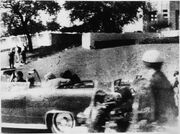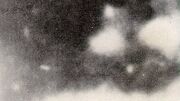
Polaroid photo by Mary Moorman taken just after the fatal shot, showing the "Badge Man" (detail)
Badge Man is the name given to a photographic image that some President John F. Kennedy assassination researchers claim is a grassy knoll assassin seen within a Polaroid photograph that close witness Mary Moorman captured on November 22, 1963 within Dealey Plaza in Dallas Texas. In the Moorman Polaroid photo (her fifth that day) is seen all of the Presidential limousine occupants, several other close witnesses (including Abraham Zapruder filming), two Dallas police motorcycle Presidential escorts, and much of the area comprising the grassy knoll. The photo has been calculated to have been captured between the Zapruder film equivalent concurrent frames of Z-315 and 316 (less than one-sixth of a second after President Kennedy's head first exploded at Z-313). On the actual Polaroid photo, the area that the Badge Man appears within is about one-quarter inch square.

An enlargement of the "Badge Man" image
In 1982 Gary Mack, the longtime curator and archivist for The Sixth Floor Museum at Dealey Plaza (the former Texas School Book Depository) first claimed to discover the "Badge Man" image. He labeled this image Badge Man because the image shows what may appear to be a uniformed police officer wearing dark clothing and his police patrolman’s metal badge on his chest and his left shoulder crest curved police patrolman patch, his hatless short hair, and the majority of his Caucasian face. Researchers claim that photogrammetric calculus methods locate the Badge Man near the foliage cover of a large oak tree on the grassy knoll, somewhere northwest of a 3.3-feet (1 m) high cement retaining wall, behind the wooden stockade fence north-south fence line, on the parking lot side, and elevated above the ground. A whitish spot slightly obscuring the Badge Man face is claimed to be the visual remnant of an already fired weapon muzzle blast, the bullet from which if fired at President Kennedy from his right front would have had to pass over the 3.3 feet (1.0 m) high cement retaining wall.
Other researchers have claimed that the "Badge Man" image is the sun-reflected outline of a soda pop bottle sitting atop the cement retaining wall. Marilyn Sitzman, who was standing a few yards from the retaining wall, saw a young black couple eating lunch on a bench behind that wall, and heard a soda bottle crash just after the motorcade passed by. Photos and films immediately afterwards do show a bottle sitting atop the retaining wall.
The House Select Committee on Assassinations sent a high-quality negative of the photo to the Rochester Institute of Technology; after enlarging the photo, no evidence of a person on the retaining wall was found. The area around the stockade fence was so underexposed, that it was deemed impossible to examine.
In the mid-1980s, assassination researcher Jack White (who testified to the House Select Committee on Assassinations) enhanced the immediate photograph area of the "Badge Man" in contrast and brightness, then he enhanced further with what White has described as “clear photographic colored oils” to illustrate the "Badge Man". White's enhancement first appeared publicly in the 1988 documentary The Men Who Killed Kennedy.
To the anatomical right (photo left) of the supposed "Badge Man" some researchers claim there is also seen a second person, self-proclaimed witness Gordon Arnold, who claimed in 1978 that he was filming the motorcade while wearing his US Army uniform when a shot passed close to his left ear. A third person claimed by researchers to be seen is a construction hard hatted accomplice to "Badge Man's" anatomical left (photo right) facing the general direction of the book depository.
Also claimed seen in the Moorman Polaroid photo by many researchers is the hatted head of a person located about 13 feet (3.9 m) west of the grassy knoll stockade fence corner (a different location from the "Badge Man"). This image area is the exact same area where several overpass witnesses stated they observed gunsmoke, where several of those gunsmoke witnesses (and other witnesses) immediately ran to, seeing no one but finding hundreds of footprints in the mud directly behind a station wagon backed up to the stockade fence that also had shoe-bottom mud scraped off onto the station wagon’s rear bumper, cigarette butts, and muddy footprints 2.5 feet (0.75 m) up on a picket fence cross-beam support. This is also the exact same location that the second major Kennedy assassination government investigation, the House Select Committee on Assassinations, determined through scientific testing that one shot was fired from.